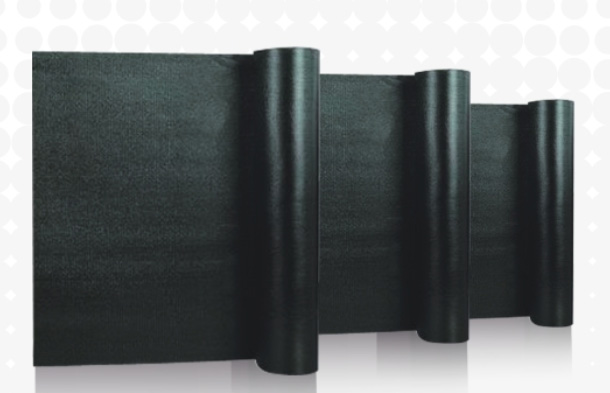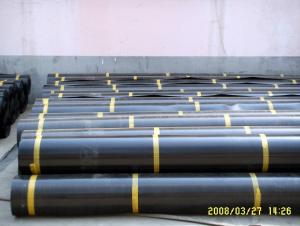Self-adhesive Waterproofing Membrane
- Loading Port:
- China Main Port
- Payment Terms:
- TT or LC
- Min Order Qty:
- 2000 M2 m²
- Supply Capability:
- Above 10000000M2 Per Year m²/month
OKorder Service Pledge
Quality Product, Order Online Tracking, Timely Delivery
OKorder Financial Service
Credit Rating, Credit Services, Credit Purchasing
You Might Also Like
Property Result
Pressure,Mpa 0.2
Keeping time, min 120, no water infiltration
Tensile strength, N/50mm ≥ 130
Elongation at break % ≥ 450
Flexibility -20℃,Φ20mm,3S,180° No cracks
Shearing performance N/mm Between membrane&membrane 2.0 or crack at outside
Between membrane&Alu.
Stripping off performance, N/mm 1.5 or crack at outside
Resistance to punching No leakage

- Q:Is a waterproofing membrane resistant to gasoline or other petroleum-based substances?
- Yes, a waterproofing membrane is typically resistant to gasoline and other petroleum-based substances. Most waterproofing membranes are made from materials such as polyurethane or PVC, which are known for their resistance to chemicals and petroleum products. This resistance ensures that the membrane remains intact and effective in preventing water infiltration even when exposed to gasoline or other petroleum-based substances. However, it is important to note that the specific resistance level may vary depending on the type and quality of the waterproofing membrane used. It is advisable to consult with a professional or check the product specifications to ensure that the chosen membrane is suitable for the intended application involving gasoline or petroleum-based substances.
- Q:Can a waterproofing membrane be used on flat roofs?
- Yes, a waterproofing membrane can be used on flat roofs. In fact, it is one of the most common and effective methods of waterproofing flat roofs. A waterproofing membrane is a thin layer of material that is applied to the surface of the roof to prevent water from penetrating through. It is typically made of a durable and flexible material, such as synthetic rubber or modified bitumen, which can withstand the elements and provide long-lasting protection. The membrane is installed in overlapping layers, creating a continuous barrier that effectively seals the roof and prevents water from leaking into the building. Additionally, waterproofing membranes can also provide insulation and energy efficiency benefits, making them a popular choice for flat roof applications.
- Q:Are there any specific considerations for installing a waterproofing membrane in high-traffic areas?
- Yes, there are specific considerations for installing a waterproofing membrane in high-traffic areas. Firstly, the membrane should be durable and able to withstand heavy foot traffic without getting damaged. It should also have a non-slip surface to ensure safety and prevent accidents. Additionally, the membrane should be easy to clean and maintain to prevent dirt build-up and maintain its functionality.
- Q:Can a waterproofing membrane be used on nickel surfaces?
- Indeed, nickel surfaces can benefit from the use of a waterproofing membrane. These membranes are frequently employed in construction and building ventures to safeguard surfaces against water damage and moisture infiltration. They serve as a barrier, preventing water from seeping through the surface and causing harm. Like any other metal surfaces, nickel surfaces can be vulnerable to corrosion and water-induced damage. By applying a waterproofing membrane, the nickel surface can be effectively shielded from water and moisture, thereby prolonging its lifespan and preserving its integrity. However, it is crucial to guarantee that the chosen waterproofing membrane is suitable for use on nickel surfaces. Different membranes may have distinct compatibility requirements, which is why it is advisable to consult the manufacturer or a professional for guidance on proper application and compatibility.
- Q:Can a waterproofing membrane be applied to horizontal surfaces?
- Yes, a waterproofing membrane can be applied to horizontal surfaces. In fact, it is commonly used to protect and waterproof horizontal surfaces such as roofs, decks, balconies, and other flat areas. The membrane acts as a barrier, preventing water from penetrating the surface and causing damage. It is typically made of a flexible material, such as rubber or modified bitumen, which can easily conform to the contours of the horizontal surface. Additionally, the membrane is designed to withstand foot traffic and other loads, ensuring long-lasting protection. Overall, applying a waterproofing membrane to horizontal surfaces is an effective way to prevent water damage and extend the lifespan of the surface.
- Q:Can a waterproofing membrane be used on aerated concrete block surfaces?
- Yes, a waterproofing membrane can be used on aerated concrete block surfaces. The membrane helps to prevent water penetration, protecting the aerated concrete blocks from moisture damage and increasing their longevity.
- Q:Are waterproofing membranes easy to install?
- Waterproofing membranes are generally easy to put in place. They can be found in various forms, such as sheets, rolls, or liquid coatings, which allows them to adapt to different surfaces and uses. Typically, the process involves cleaning and preparing the surface, applying the membrane, and ensuring a proper seal. While some technical knowledge and tools may be necessary, manufacturers often provide detailed instructions and guidelines for installation, making it easier for professionals and DIY enthusiasts alike. Furthermore, advancements in technology have resulted in the creation of self-adhesive membranes, which make the installation process even simpler. All in all, with proper preparation and following the correct installation procedures, waterproofing membranes can be installed relatively effortlessly.
- Q:Are waterproofing membranes suitable for residential applications?
- Yes, waterproofing membranes are suitable for residential applications. They are commonly used in various areas of residential construction, such as basements, foundations, roofs, bathrooms, and balconies, to prevent water penetration and protect the building structure from moisture damage. Waterproofing membranes provide a barrier against water, preventing it from seeping into the structure and causing issues like mold, rot, or structural damage. These membranes are typically made of materials like bitumen, PVC, EPDM, or polyurethane, which are highly effective in repelling water. In residential constructions, waterproofing membranes are installed during the building process or as a part of renovation projects. They can be applied as a liquid coating or in the form of sheets that are laid down and adhered to the surface. These membranes create a seamless and durable barrier that can withstand the test of time. Additionally, waterproofing membranes offer various benefits for residential applications. They help maintain a dry and comfortable living environment by preventing water leaks and dampness. This, in turn, protects the integrity of the building materials, prolongs the lifespan of the structure, and reduces the risk of costly repairs. Furthermore, waterproofing membranes can also enhance energy efficiency by reducing moisture-related heat loss or gain. By preventing water infiltration, they help maintain consistent temperatures inside the house, resulting in lower energy consumption and utility bills. Overall, waterproofing membranes are an excellent choice for residential applications. They provide reliable protection against water damage, improve the longevity of the structure, and contribute to a healthier and more energy-efficient living environment.
- Q:Can a waterproofing membrane be used for bridges or viaducts?
- Bridges or viaducts can benefit from the use of a waterproofing membrane. These structures endure various weather conditions, such as rain, snow, and humidity, which can cause harm if not adequately protected. The purpose of a waterproofing membrane is to create a barrier against water infiltration, preventing moisture from seeping into the structure. By doing so, it safeguards the concrete or steel components, minimizing the risk of corrosion and other forms of deterioration. Moreover, the application of a waterproofing membrane can prolong the lifespan of the bridge or viaduct, resulting in reduced expenses for maintenance and repairs over time.
- Q:Can waterproofing membranes be used on mechanical equipment rooms?
- Waterproofing membranes are suitable for application in mechanical equipment rooms. These membranes have been specifically designed to create a protective barrier, safeguarding against water penetration and preventing any potential harm caused by moisture to the underlying structures. The installation of these membranes within mechanical equipment rooms, which often house valuable and sensitive machinery, proves advantageous as it ensures the durability and functionality of the equipment. By applying waterproofing membranes to the walls, floors, and ceilings of these rooms, it effectively prevents water leaks, moisture accumulation, and any potential harm resulting from water infiltration. This is particularly crucial in regions that experience heavy rainfall, high humidity, or possess a high water table. Additionally, the use of waterproofing membranes aids in regulating condensation and discouraging the growth of mold, both of which could adversely impact the performance of mechanical equipment. In summary, the utilization of waterproofing membranes in mechanical equipment rooms offers a practical and efficient solution for equipment protection and the maintenance of optimal performance.
We are a well-known Brand specializing in the production and sales of high-grade waterproofing materials.Our waterproof systems are widely applied to general buildings, highways, bridges, subways, tunnels, airports and dams.Our brand sticks to globalization. Products can reach various international standards and have been exported to more than 40 countries and regions.
1. Manufacturer Overview |
|
|---|---|
| Location | Beijing, China |
| Year Established | 1998 |
| Annual Output Value | Above US$ 30 Million |
| Main Markets | Mid East; Eastern Europe; North America; Southeast Asia |
| Company Certifications | ISO 9001 |
2. Manufacturer Certificates |
|
|---|---|
| a) Certification Name | |
| Range | |
| Reference | |
| Validity Period | |
3. Manufacturer Capability |
|
|---|---|
| a)Trade Capacity | |
| Nearest Port | Tianjin |
| Export Percentage | 41% - 50% |
| No.of Employees in Trade Department | Above 50 People |
| Language Spoken: | English; Chinese |
| b)Factory Information | |
| Factory Size: | Above 600,000 square meters |
| No. of Production Lines | Above 10 |
| Contract Manufacturing | OEM Service Offered; Design Service Offered |
| Product Price Range | Negotiated |
Send your message to us
Self-adhesive Waterproofing Membrane
- Loading Port:
- China Main Port
- Payment Terms:
- TT or LC
- Min Order Qty:
- 2000 M2 m²
- Supply Capability:
- Above 10000000M2 Per Year m²/month
OKorder Service Pledge
Quality Product, Order Online Tracking, Timely Delivery
OKorder Financial Service
Credit Rating, Credit Services, Credit Purchasing
Similar products
New products
Hot products
Hot Searches
Related keywords



























